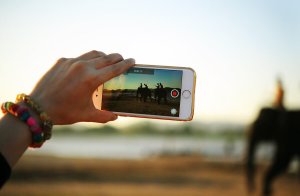How to Build a Tourism Marketing Content Plan for Your Destination
November 21, 2024
If you’ve found your way to this blog, chances are you already know how important a tourism marketing plan is to your destination. A well-defined strategy allows a DMO to showcase its destination’s unique assets, drive hotel bookings, and support its local economy. It ensures that marketing efforts are not only aligned with the destination’s goals but also focused on driving sustainable tourism growth and fostering community engagement. With a structured (yet flexible) approach to destination marketing, DMOs can more efficiently manage marketing resources and budget for a positive impact on their community.
Sounds simple in practice, right? When you factor in things like managing local sentiment, fostering partnerships, attributing spend to results, and rapidly evolving marketing channels, it becomes even more difficult to hone in on a well-defined tourism marketing plan. That’s why the best and most complex marketing strategies start with the basics.
Tourism Marketing Basics
As Larry Bird once said, “First, master the fundamentals.” While he may have been referring to basketball basics, the same applies for your brand. Before you can create a tourism marketing plan, you have to truly understand what it is you are offering. This is your distinct identity in the perception of consumers. The American Marketing Association defines brand marketing as connecting emotionally with consumers to build loyalty, and drive sales.
Larry Bird
“First, master the fundamentals.”
Our work with clients to develop and master their brand typically begins with a brand workshop. Like building a puzzle, this is where we dig into data to piece together all elements of a destination — looking at the DMO as an organization, the community, the culture, the consumer, and the competition.
With a better understanding of each piece of the brand puzzle, we can begin to pull together brand pillars that will guide all messaging and creative work for a unified tourism marketing plan.
“A lot of people think marketing is just magic, bells, and whistles,” said Lesley Rowbal, Destination Strategy Director at Madden. “We take a data-first approach, but that alone is not enough. All your marketing efforts need to ladder up to your organizational and strategic goals. It’s not just about heads in beds.”
Check out how we worked with Alabama’s Beaches to develop a new brand to maintain relevance in a competitive market.
Best practices for digital marketing in tourism
Keyword research is essential in tourism marketing plans because it reveals exactly how travelers are searching for your destination. With over 8 billion searches happening each day on Google, by understanding the words and phrases potential visitors use, you can align your content to match their interests, questions, and needs, making it easier for them to find you.
These terms and topics can then be incorporated into a content calendar to keep your content organized and consistent, ensuring timely and relevant material that engages travelers and strengthens your online presence.
There are a number of paid tools that can help you dive into keyword research and SEO experts are skilled in analyzing the results and developing strategies to boost SEO through content and technical adjustments to websites. Google also offers a free keyword planner to help you begin uncovering keywords related to your destination.
As a best practice for digital marketing in tourism, optimizing your organic content for SEO not only boosts your destination’s visibility in search results but also positions your site as a credible, go-to resource, increasing the likelihood of converting casual browsers into enthusiastic travelers.
“We’re always working to strike that perfect balance between user experience and making sure the content is delivered to the right people when they’re searching for it,” explained Stacey Gregory, Content Director at Madden. “In today’s technical landscape, content has to appeal to people and to AI models. The tools we use are critical in helping uncover the right words that we, in turn, use to craft and mold messages within the established brand voice.”
We Know Our Target Keywords, Now What?
Once you’ve identified your target keywords, the next step is to transform them into a strategic content plan that consistently draws in and engages potential travelers. Start by brainstorming content topics based on these keywords, focusing on creating valuable, informative, and inspiring content that aligns with what travelers are genuinely interested in. Think about the questions visitors may have at each stage of their journey, and craft topics that address their needs, from pre-trip planning to local insider tips. As you brainstorm, remember to stay grounded in your brand pillars. They serve as the foundation of your storytelling, ensuring that every piece of content aligns with your destination’s core values and unique identity.
Building a Content Calendar
With these topics in hand, you can build a content calendar that organizes when and where each piece will be published to ensure consistency and alignment with your brand pillars and goals. Tools like Notion or Monday can help manage this process, offering flexible, collaborative platforms where your team can plan, assign, and track each piece of content from brainstorming to publication. By using a dedicated system, you can set up workflows to streamline production, schedule regular content updates, and monitor engagement metrics.
Establish key performance indicators (KPIs) to measure success, and be prepared to adjust the strategy based on engagement and feedback to ensure it continually resonates with travelers. Among the best practices for digital marketing in tourism, a well-crafted content calendar not only keeps audiences engaged but also builds trust and drives more conversions by consistently delivering value and inspiration.
Strategies for Specific Types of Travelers
It’s no secret that there are all types of travelers, each with unique interests, goals, and needs when exploring new destinations. A strong content strategy allows you to tailor messaging that speaks directly to each audience segment, providing the information and inspiration to move each one. Tourism marketing involves understanding these diverse travel types — such as adventure seekers, food lovers, and families — to create meaningful connections and engage each group with relevant, appealing content. Let’s dive into a few types of travelers (check out our full list of traveler profiles here).
Unique Marketing Strategies for Adventure Tourism
Adventure travelers crave excitement, physical activity, and new challenges. According to our Voyage Atlas data, they make up a reachable audience of more than 117 million people. Content for this segment should focus on showcasing outdoor experiences, adrenaline-pumping activities, and lesser-known spots for exploration. Consider creating an “adventure guide” that highlights seasonal activities like rock climbing, zip-lining, or white-water rafting. Feature user-generated content, such as photos or stories from past visitors, to create authenticity and inspire confidence. Videos and immersive content, like 360-degree tours or interactive maps can also create a unique marketing strategy for adventure tourism to help adventure seekers visualize and feel connected to the experiences your destination offers.
Unique Strategies for Foodie Tourism
For foodies, a destination’s culinary scene is a major draw. Voyage Atlas data shows messaging targeting these travelers should emphasize excitement and originality mixed with indulgence. Build your content around features like chef interviews, profiles of local restaurants, or farm-to-table experiences. A behind-the-scenes look at local food production, such as visiting vineyards or farms, can add depth to your storytelling. Consider creating a “food trail” itinerary to give these travelers a taste of the unique culinary experiences waiting for them in your destination.
Unique Strategies for Family-Friendly Tourism
Families seek destinations that offer safe, accessible, and engaging experiences for all ages. Content for this audience should focus on family-friendly attractions, educational opportunities, and multi-generational activities. Create “family itineraries” with recommendations for kid-approved activities, interactive museums, and outdoor spots like parks and playgrounds. Highlight convenience aspects, such as nearby family-friendly dining options, accommodations with amenities like pools or game rooms, and transportation tips to make planning easier for parents. Featuring testimonials from other families or sharing insider tips can provide assurance to this audience, making them more likely to choose your destination for their next trip.
Developing unique strategies for each travel segment is among the best practices for digital marketing in tourism, making your destination more appealing to a wider range of travelers.
Amplify your reach
Creating a tourism marketing plan that is anchored in a clear brand identity, optimized for SEO, and supported by a strong, strategic content approach ensures that your destination stands out and resonates with the right audiences. With this solid foundation, you’re primed to amplify your reach even further — whether through paid media, targeted advertising, or other marketing tactics that can take your strategy to the next level.



